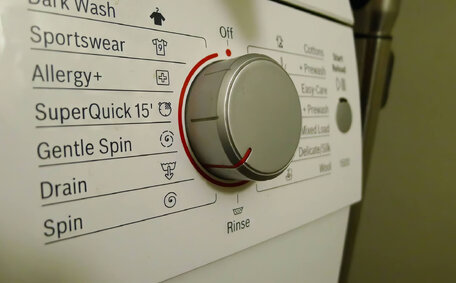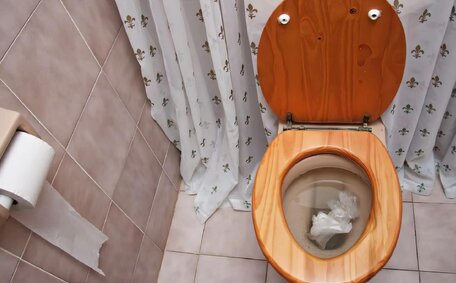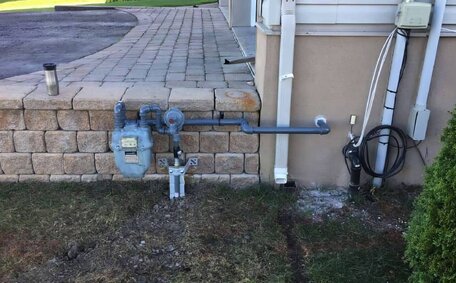Introduction to Discolored Hot Water
Many homeowners encounter the issue of discoloured hot water, often presenting as a brownish hue. The discoloration is often caused by the buildup of rust, sediment, minerals and corrosion inside your water heater, pipes, or taps. Left unchecked, discoloured water presents risks to your health and plumbing system.
This guide delves into the root causes of brown or discoloured hot water, highlights the risks of neglect, and explores both DIY fixes and when to seek professional help to restore clear water flow. Additionally, we’ll provide strategies to prevent and handle water heater issues, thus avoiding discolouration.
Our guide provides actionable steps for tackling the source of your dirty tap water and flushes for water heaters and pipes. Understand the root causes and solutions to promptly address these issues before they escalate into major problems.
Common Causes of Discolored Hot Water
Several key factors typically lead to water discolouration, causing your hot water to appear brown:
Rust and Corrosion
Rusty water results from aging pipes, tank corrosion, and erosion of internal components, often causing brown discolouration in your hot water. As metal structures corrode from exposure to water and minerals, rust flakes can break off and enter the flow resulting in discoloration.
Sediment Buildup
Sediment, primarily from iron and manganese, can accumulate in your water heater, affecting the anode rod and pipes. As the flow disturbs these mineral deposits within hot water your system over time, discoloration occurs due to sediments being released and suspended in the water.
Old Piping and Fixtures
Outdated pipes constructed from materials like galvanised steel often succumb to internal corrosion and rust. This contamination will impart a brown tinge when tiny air bubbles and fragments enter the hot water flow. Similarly, worn faucets, valves and fittings may shed metal particles leading to discoloration issues.
Rusty Pipes and Corrosion
As pipes age, corrosion can occur both internally and externally, contributing to rust formation. This issue is frequently seen affecting your old iron pipes which are highly reactive when exposed to water over prolonged periods.
Internal rust flakes and iron oxide particles in old pipes are prime culprits for discoloured water. Passing through deteriorating pipes, water stirs up rust sediment, leading to a brownish tinge.
Externally, corrosion forms rust patches on the outer surface of pipes. Eventually, this corrosion can eat right through causing leaks where water comes from. But before a total breach occurs, flecks of exterior pipe rust can still contaminate your hot water with brown water coming out as flow disturbance detaches rust particles.
Replacing severely corroded pipes is the ultimate solution. However, options like flushing to clear sediment or installing a pipe lining to rehabilitate worn pipes remain viable. Contact us if you identify rust in the water pipes as the potential problem your experiencing with discoloured hot water.
Mineral Buildup and Sediment
Dissolved sediments and minerals can cause brown discoloration and may contribute to wider water quality issues. Substances like iron, manganese, calcium, and magnesium are common minerals found in well water and many other water sources. Over time, these minerals can accumulate and be disturbed, leading to discolouration in your home’s hot water system.
A water softener in your household helps limit the scale buildup from minerals in your cold water system. System flushing can help clear loose sediment from your water heater and pipes. However, when faced with excessive accumulation, it may require the installation of new hot water system components or pipe replacement.
If discolouration or issues with hot water arise after nearby construction, contact your water provider to investigate potential contamination from disturbed pipes and sediments entering the supply.
Bacteria and Biofilm
Some bacteria can cause discolouration by promoting biofilm growth inside pipes and appliances when water conditions permit. These bacteria are more likely to be present in some plumbing systems, feeding on minerals and organic matter, causing rusty discoloration.
As bacterial colonies expand, they secrete a slimy, glue-like film known as biofilm that adheres into your pipe and tank walls. The biofilm creates a protective barrier for continued bacterial growth. Over time, stray flecks of biofilm can water flow through the pipes causing visible discoloration in both hot and cold water flow.
Bacterial by-products, like hydrogen sulphide, can react with metals in your pipes, producing compounds that tinge the water black. Bacterial accumulation thus leads to direct and indirect colouration of water in your pipes.
Sanitising your pipes with shock chlorination is efficacious in managing both cold hot water to reduce brown discoloration from biofilm and bacteria. Professional cleaning and maintenance services can eliminate brown water, ensuring your tank and pipes deliver clean, safe water and prevent further growth. Removing the food source via water softeners also limits reoccurrence.
If discoloured water persists and bacterial contamination is suspected, indicated by visual signs or unpleasant odours, immediate testing and treatment are essential. Catching an infection early vastly simplifies eradication before proliferation and equipment damage occurs.
Is Discolored Water Safe?
What do you do when confronted with brown tap water from your taps? It’s only natural to have concerns over health and safety risks. Identifying what could be causing the murky appearance of your water is key to understanding if the discoloured tap is safe to use.
Temporary discoloration from sediments or minerals in the pipes and appliances is typically safe to drink and doesn’t pose major health risks. While aesthetically displeasing, consuming mildly discoloured water for short periods is generally not harmful.
However, severely discoloured water with unpleasant odours or tastes should be ingested with caution. Similarly, if coloration from a brown water tap persists beyond a day or reoccurs frequently, presenting a brown yellow hue, hot water should be tested before drinking to determine the cause and rule out bacterial contamination.
After sudden discoloration, it’s advisable to avoid drinking tap water for a few hours to see if the issue resolves itself. Run both hot and cold taps and flush the pipes until the water runs clear, checking for sediment clearance. Check sinks, baths and outdoor taps as issues can be isolated. If brown water hot from your tap continues, please call a plumber to arrange water testing and contact us regarding full system inspection and servicing.
If safety is questionable due to unexplained discoloration, avoid using the water until a water quality assessment clarifies the issue. It’s time to seek professional help promptly to solve the problem and identify and resolve underlying factors causing coloured water.
How to Troubleshoot Discolored Hot Water
Troubleshooting discoloured hot water calls for methodically checking different water sources in your home to isolate issues with minerals such as calcium or magnesium. Here are steps you can take:
- Inspect hot and cold tap water at all sinks, showers, and bathtubs. Compare hot vs cold water coloration.
- Examine both the hot and cold supply lines under sinks within few respective areas. Rust is often responsible for water discoloration.
- Inspect your water tank and associated pipes for corrosion and sediment buildup that can become dislodged.
- Run only your cold water for a few minutes to help flush the pipes and ascertain if the water discoloration issue is specific to the cold water only.
- Inspect the water metre and garden tap to isolate if discoloration is from municipal supply or internal plumbing.
- Persistent brown discoloration in hot water, following the initial checks, may indicate a problem with the municipal supply., so proceed to drain and flush the water heater per manufacturer guidance.
- For isolated or intermittent discoloration, arrange inspection and maintenance to clean affected pipes and fittings.
- If attempts fail to resolve discoloration, professional servicing is recommended involving water testing to determine contaminant levels.
Regularly consulting a plumber for water infrastructure maintenance, including periodic flushing, can help keep pipes free from sediment and corrosion. Before they cause significant issues, seek to call professional help to flush out unresolved hot water discoloration and prevent pipe deterioration or risks from bacterial growth.
When to Call a Professional Plumber
Based in Padstow, Sydney, we advise seeking professional assistance if discoloured water persists after you’ve completed the troubleshooting steps. Signs that expertise is needed include:
- Rusty hot water discoloration reoccurs frequently despite flushing the pipes and water heater.
- Water remains/ the hot water brown, black or yellow despite isolating and checking all taps.
- Unpleasant smells or taste accompany the discoloured water.
- Visible pipe corrosion is allowing contaminants or sediments into the water flowing throughout your home.
- Testing confirms elevated bacteria levels or other dangerous contaminants.
Our Padstow-based licensed plumbers offer comprehensive services including diagnostics and repairs for brown water issues, with thorough water testing and pipe inspections. We can then advise on solutions such as cleaning, repairs, parts replacement or whole water heater upgrades.
If you require help with persistent brown tap water issues, feel free to email or call us for assistance.
Preventing Discolored Hot Water
Taking preventative measures helps avoid discoloured hot water issues occurring down the track. This saves on future repair costs and the hassle of interruptions to your hot water supply. Recommended maintenance tips include:
Flush Water Heaters Annually
Flushing your hot water tank every 12 months removes built up sediment and minerals. Follow manufacturer guidance or contact us to professionally flush and service your system.
Install Water Treatment Filters
Water softeners and inline sediment filters help capture contaminants before they make their way into your water system. They remove minerals and particles to maintain water clarity while also inhibiting scale buildup and corrosion inside pipes and appliances.
Upgrade Old Steel or Galvanised Pipes
Replacing outdated piping removes a major source of internal corrosion and rust contamination. We advise upgrading old pipe infrastructure to eliminate brown discolouration.
Shock Chlorinate Water Tanks Annually
Yearly chlorination of water tanks kills bacteria that can produce slime, contributing to contaminated water. Remember to run all taps to flush the chlorinated water out your system after treatment.
Schedule maintenance checks to examine your plumbing system for emerging issues before they escalate. Investing in preventative care can do wonders for reducing headaches down the track while ensuring the ongoing delivery of clean, safe water.






